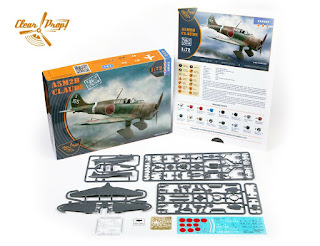Another 'lost and found' RAF Flying Review article in this occasional series, this time from the March 1959 (Vol.XIV No.7) issue and featuring an interesting account of the Yokosuka (Kugisho) R2Y Keiun (景雲 - 'Auspicious Cloud') experimental reconnaissance aircraft by Mr Ichiro Naito, translated by Mr Takeshi Hattori and published therein by courtesy of the Japanese magazine Aireview.
English language data on Keiun is sparse so Mr Naito's first person account is especially welcome for its details even if 60 years old! A Model 2 (R2Y2) variant of the type was planned to be powered by a Mitsubishi Ne-330 turbo-jet engine fitted to each wing (as shown above in the article's side-view plan).
Fine Molds Keiun 1995
Fine Molds Keiun 2001
Fortunately for those modellers interested in Japanese experimental types there is a decent 1/72 kit of the fascinating Keiun by Fine Molds. First released in 1995 it was re-released in 2001 with new box art depicting orange-yellow under surfaces. The kit is currently in stock at HLJ for a very reasonable £11.91 (US$15.91) and there is a photo-etch details accessory set AA-17 available separately at £7.74 (US$9.92). A 1/72 resin model of the turbo-jet powered R2Y2 was announced for release this month by International Resin Modelers but comes with a hefty price tag of US$100 for non-members.
A splendid model of Keiun built from the Fine Molds kit is shown here (above and below) courtesy of the builder Mr Hiroyuki Kato via Mr Hiromichi Taguchi, the editor of the excellent Japanese monthly web magazine Web-modelers. Mr Taguchi's web magazine should be of special interest to those who enjoy seeing older kits as well as recent releases carefully built and painted. The magazine also features nostalgic articles about Japanese aviation and modelling history, including past times Japanese model shops and modelling magazines. All the back issues of the magazine can be browsed at the website.
With special thanks to Mr Hiroyuki Kato and Mr Hiromichi Taguchi for their kind permission to share the images of Mr Kato's Keiun model with Aviation of Japan. The RAF Flying Review article is from the author's own collection of the magazine. Please credit and link to Aviation of Japan if referencing this article or its contents, including Wiki updates, thank you.
Image credits: Heading image via web; Magazine pages © 1959 The RAF Review Ltd; Box art © 1995 & 2001 Fine Molds Corp.; Keiun model images © 2019 Hiroyuki Kato via Hiromichi Taguchi & Web-modelers.














































